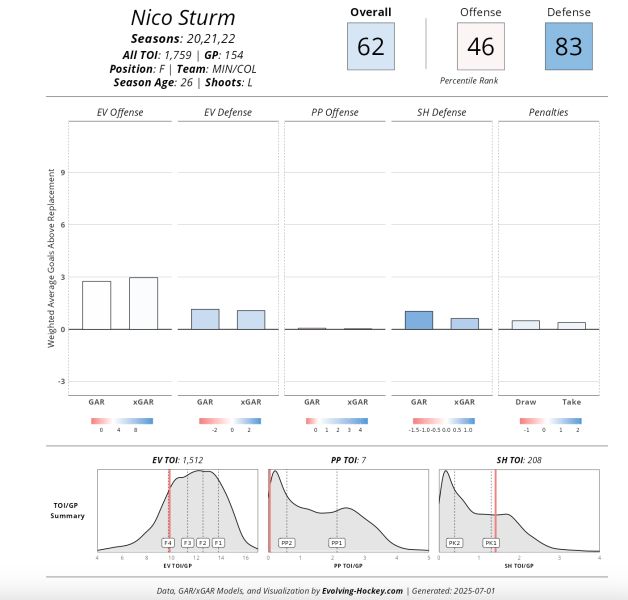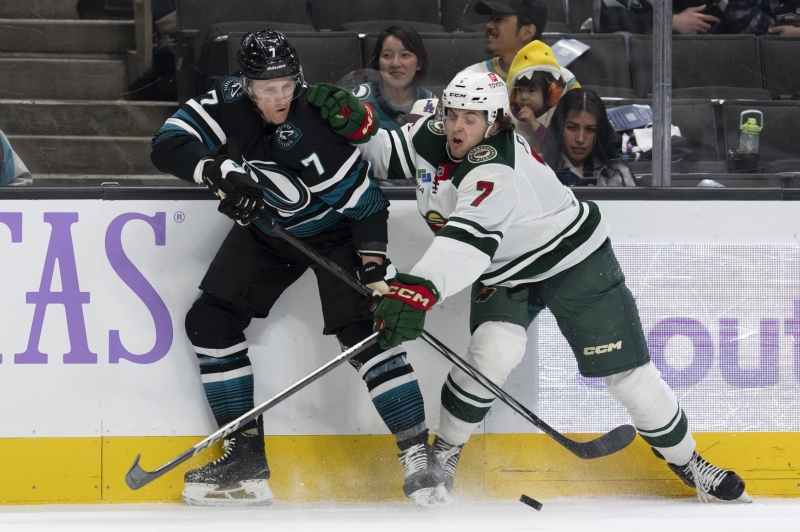Nico Sturm is back in St. Paul, and the 6-foot-3 center has gained some considerable bulk since he left in 2022. He’s two Stanley Cup rings heavier this time around. After hopping aboard the Colorado Avalanche during their Cup run, Sturm had a stop in San Jose before catching on with the Florida Panthers at the trade deadline. Now, he’s signed with the Minnesota Wild for two years and a $2 million cap hit.
Sturm brings more to the table — we’ll get to that in a bit — but this signing is about one thing, and one thing only.
The penalty kill.
Teams have killed the Wild while shorthanded, almost from the moment Sturm left. Below is their PK Success rate by year.
2022-23: 82.0% (10th in the NHL)
2023-24: 74.5% (30th)
2024-25: 72.4% (30th)
Honestly, it’s surprising that they had one good year. It’s felt like the Wild’s penalty kill has been a significant shortcoming for much longer than two years, but that highlights how much having a bad unit warps time and space. If two minutes is an eternity, what does that make two years of awful shorthanded results?
While the Wild survived their awful PK last year, their shorthanded game arguably sank them in every playoff series since Sturm left. In three trips, the Wild have allowed 21 goals on 66 opportunities (a measly 68.2% success rate), getting lit up in each series. Even against the Vegas Golden Knights, in a series where Jack Eichel and Mark Stone couldn’t buy a goal, they still went 5-for-18 on their power play chances.
That was the Wild’s BEST showing over that time, mind you.
Minnesota already attempted to fix the penalty kill last season, signing Yakov Trenin to a four-year, $3.5M AAV deal. Trenin started the season as John Hynes’ go-to killer, leading the team in shorthanded minutes through December 31. However, the forechecking forward lost Hynes’ confidence after that, at least somewhat. From January 1 on, he was just fourth in shorthanded ice time. By the playoffs, Trenin was out of the rotation entirely.
So, take two. Sturm’s not just going to be counted on to shore up the penalty kill for the regular season, but to be the piece that makes the unit playoff-worthy.
Is he up for the task?
Looking at his track record of killing penalties in San Jose, you don’t see all that much to get excited about. While the Sharks fared slightly better than the Wild shorthanded, they were still 27th in PK Success rate (74.2%) last season, and 28th (75.2%) the year prior. Sturm wasn’t an insignificant part of that unit, logging 175 shorthanded minutes for the Sharks (201 total) over that time, third behind only Wild Legends Luke Kunin and Mikael Granlund.
Yet among 187 forwards with 100-plus PK minutes in the past two years, Sturm is 137th in goals against per hour (8.62) and 166th in expected goals against per hour (10.21). It must be said that both numbers are an improvement over Joel Eriksson Ek during that span… but jeez, not by much.
Of course, the Sharks aren’t exactly what you’d call a “structured” team, but Sturm still lagged behind some of his teammates in San Jose. Barclay Goodrow and William Eklund had a better time of limiting goals, while those two and Kunin all performed better at limiting scoring chances. You might expect to see Sturm’s numbers suffer in San Jose, but you’d at least hope he could outshine his teammates.
But, hey, let’s give him a pass for being on the Sharks, whose goalies have been 32nd in 5-on-5 save percentage during those three seasons. What about when he’s played in the playoffs on good teams?
Sturm has only played 47 4-on-5 minutes on three playoff runs. That’s not a big sample, but almost no one has a big sample of shorthanded playoff minutes. There are just 100 forwards who have 30-plus 4-on-5 minutes since the 2020-21 season. It’s not a ton to go on, but it’s what we have, and analyze it we must.
As it turns out, Sturm has been pretty good at both limiting goals and scoring chances. He’s 36th of our 100-forward sample in goals allowed per hour (5.95) and expected goals per hour (7.26). In terms of limiting actual goals, he’s ahead of Eriksson Ek (who holds a slight edge in limiting expected goals during the playoffs), but that’s not who Sturm is replacing.
Sturm’s addition will likely bump Eriksson Ek to the second PK unit, which is some needed help for the rugged all-situations center. Still, the real value add is essentially swapping him with Freddy Gaudreau. There were roles where Gaudreau was useful, but killing penalties wasn’t one of them. In our 100-forward playoff sample, Gaudreau ranked dead-last in actual goal rate (17.9 per hour) and expected goal rate (13.2 per hour).
To say Gaudreau wasn’t working on the PK almost undersells it.
The verdict here: Sturm might not cure the Wild’s penalty kill, but he helps a lot. Luckily for them, he’s not a one-note player. He couldn’t keep up the top-tier defensive play in San Jose (could anyone have?), but he thrived in Minnesota on both sides of the puck in a fourth-line role.

Granted, these numbers are from three years ago, and Sturm is now 30, not 26. He lost a step last year. He’s missed parts of the past two seasons, which may have been a factor. Still, Sturm is an above-average skater for a big man. While John Hynes is the coach now, instead of Dean Evason, there is a fair amount of continuity for Sturm to fall back into. The Wild will use him as a heavy forechecker, and if he can get back up to speed, he should be very effective at it.
He can also bring a sneaky offensive element to the table. Last season, he averaged 0.72 expected goals per hour at 5-on-5, which puts him at a slight step above a typical fourth-line player. An ability to get some scoring chances on the fourth line might end up being an offensive upgrade from someone like Gaudreau. Watch out for it.
If Sturm can help out on the PK, then this is a more-than-reasonable move for the Wild. $2 million on a cap hit is (slightly) less than Gaudreau’s outgoing hit, and having him for two years instead of three is a good trade-off. It’s not quite Christmas morning, but it’s something.
